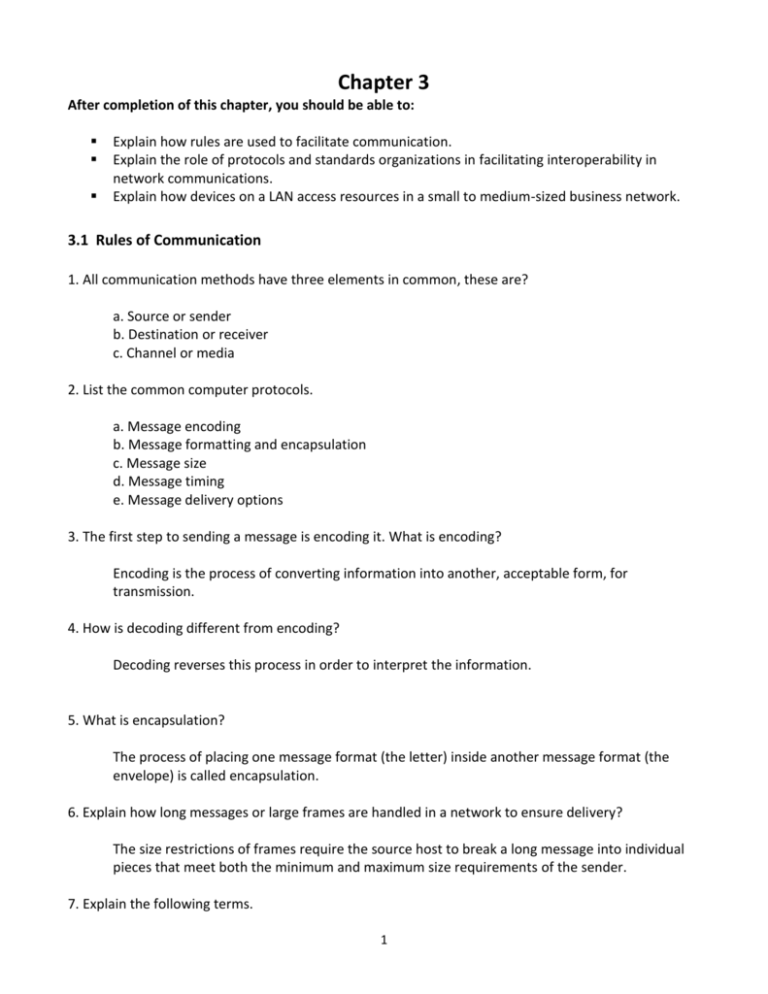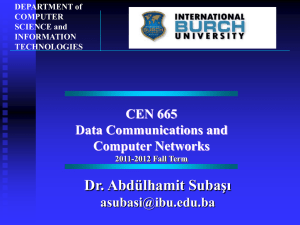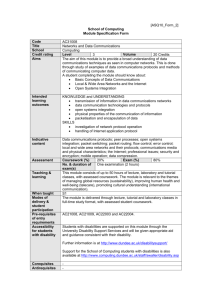Chapter 03 - Reading Organizer
advertisement

Chapter 3 After completion of this chapter, you should be able to: Explain how rules are used to facilitate communication. Explain the role of protocols and standards organizations in facilitating interoperability in network communications. Explain how devices on a LAN access resources in a small to medium-sized business network. 3.1 Rules of Communication 1. All communication methods have three elements in common, these are? a. Source or sender b. Destination or receiver c. Channel or media 2. List the common computer protocols. a. Message encoding b. Message formatting and encapsulation c. Message size d. Message timing e. Message delivery options 3. The first step to sending a message is encoding it. What is encoding? Encoding is the process of converting information into another, acceptable form, for transmission. 4. How is decoding different from encoding? Decoding reverses this process in order to interpret the information. 5. What is encapsulation? The process of placing one message format (the letter) inside another message format (the envelope) is called encapsulation. 6. Explain how long messages or large frames are handled in a network to ensure delivery? The size restrictions of frames require the source host to break a long message into individual pieces that meet both the minimum and maximum size requirements of the sender. 7. Explain the following terms. 1 a. Message Timing – People use timing to determine when to speak, how fast or slow to talk, and how long to wait for a response. These are the rules of engagement. b. Access Method – Access method determines when someone is able to send a message. c. Collision – If two people talk at the same time, a collision of information occurs and it is necessary for the two to back off and start again d. Flow Control – Timing affects how much information can be sent and the speed that it can be delivered. Source and destination hosts use flow control to negotiate correct timing for successful communication. e. Response Timeout – Hosts on the network have rules that specify how long to wait for responses and what action to take if a response timeout occurs. 8. Explain the following terms. a. Unicast – A one-to-one delivery option is referred to as a unicast, meaning that there is only a single destination for the message. b. Multicast – When a host needs to send messages using a one-to-many delivery option, it is referred to as a multicast. Multicasting is the delivery of the same message to a group of host destinations simultaneously. c. Broadcast – 2 If all hosts on the network need to receive the message at the same time, a broadcast is used. Broadcasting represents a one-to-all message delivery option. Additionally, hosts have requirements for acknowledged versus unacknowledged messages. 3.2 Network Protocols and Standards 9. Explain what a protocol suite is and what devices implement or use them? A group of inter-related protocols necessary to perform a communication function. Protocol suites are implemented by hosts and networking devices in software, hardware or both. 10. What is a protocol stack? A protocol stack shows how the individual protocols within a suite are implemented. 11. In a protocol stack the protocols are viewed in terms of layers. How do these layers interact with each other? Each higher level service depends on the functionality defined by the protocols shown in the lower levels 12. What do the lower layers in the protocol stack focus on? a. Moving data over the network b. Providing services to the upper layers 12. What do the upper layers in the protocol stack focus on? The content of the message being sent. 13. What are the three layers in the protocol stack? a. Physical layer b. Rules layer c. Content layer 14. For devices to successfully communicate, a network protocol suite must describe precise requirements and interactions. What do networking protocols define? A common format and set of rules for exchanging messages between devices. 15. List some common networking protocols. 3 a. IP b. HTTP c. DHCP 16. Describe some of the processes networking protocols are responsible for. a. How the message is formatted or structured. b. The process by which networking devices share information about pathways with other networks. c. How and when error and system messages are passed between devices. d. The setup and termination of data transfer sessions. 17. Explain in detail how the following protocols operate. (in detail means more than one sentence) Application Protocol - Hypertext Transfer Protocol (HTTP) – Is a protocol that governs the way a web server and a web client interact. HTTP defines the content and formatting of the requests and responses that are exchanged between the client and server. Transport Protocol - Transmission Control Protocol (TCP) – Is the transport protocol that manages the individual conversations between web servers and web clients. TCP divides the HTTP messages into smaller pieces, called segments. These segments are sent between the web server and client processes running at the destination host. TCP is also responsible for controlling the size and rate at which messages are exchanged between the server and the client. Internet Protocol – IP – 4 Is responsible for taking the formatted segments from TCP, encapsulating them into packets, assigning them the appropriate addresses, and delivering them across the best path to the destination host. Network Access Protocols – Network access protocols describe two primary functions, communication over a data link and the physical transmission of data on the network media. Data-link management protocols take the packets from IP and format them to be transmitted over the media. The standards and protocols for the physical media govern how the signals are sent and how they are interpreted by the receiving clients. An example of a network access protocol is Ethernet. 18. The protocols IP, HTTP, and DHCP are all part of the Internet protocol suite known as: Transmission Control Protocol/IP (TCP/IP) 19. The TCP/IP protocol suite is an open standard. Explain what that means. These protocols are freely available to the public, and any vendor is able to implement these protocols on their hardware or in their software. 20. Explain what a standards-based protocol is. It is a process or protocol that has been endorsed by the networking industry and ratified, or approved, by a standards organization. 21. Explain in detail why it’s important to have standard based protocols. The use of standards in developing and implementing protocols ensures that products from different manufacturers can interoperate successfully. If a protocol is not rigidly observed by a particular manufacturer, their equipment or software may not be able to successfully communicate with products made by other manufacturers. 22. Explain in detail what proprietary protocols are. Proprietary means that one company or vendor controls the definition of the protocol and how it functions. Some proprietary protocols can be used by different organizations with permission from the owner. Others can only be implemented on equipment manufactured by the proprietary vendor. 23. Is Cisco’s EIGRP routing protocol proprietary or non-proprietary? 5 Non-proprietary 24. The IP suite is a suite of protocols required for transmitting and receiving information using the Internet. It is commonly known as TCP/IP. 25. What year was the TCP and IP protocols formalized? 1981 26. What year did Cisco launch its first routing innovation? 1986 27. Explain the protocol steps involved in during the communication process after a remote computer requests a webpage from a web server. a. The web server’s Hypertext Markup Language (HTML) page is the data to be sent. b. The application protocol HTTP header is added to the front of the HTML data. The header contains various information, including the HTTP version the server is using and a status code indicating it has information for the web client. c. The HTTP application layer protocol delivers the HTML-formatted web page data to the transport layer. The TCP transport layer protocol is used to manage the individual conversation between the web server and web client. d. Next, the IP information is added to the front of the TCP information. IP assigns the appropriate source and destination IP addresses. This information is known as an IP packet. e. The Ethernet protocol adds information to both ends of the IP packet, known as a data link frame. This frame is delivered to the nearest router along the path towards the web client. This router removes the Ethernet information, analyzes the IP packet, determines the best path for the packet, inserts the packet into a new frame, and sends it to the next neighboring router towards the destination. Each router removes and adds new data link information before forwarding the packet. f. This data is now transported through the internetwork, which consists of media and intermediary devices. g. The client receives the data link frames that contain the data and each protocol header is processed and then removed in the opposite order that it was added. The Ethernet information is processed and removed, followed by the IP protocol information, then the TCP information, and finally the HTTP information. h. The web page information is then passed on to the client’s web browser software. 6 28. Fill in the correct protocols. 29. Standards organizations are usually vendor-neutral, non-profit organizations established to develop and promote the concept of open standards. 30. Explain the function and responsibility of each of the following standards organizations. a. The Internet Society (ISOC) – Is responsible for promoting open development, evolution, and Internet use throughout the world. ISOC facilitates the open development of standards and protocols for the technical infrastructure of the Internet, including the oversight of the Internet Architecture Board (IAB). b. The Internet Architecture Board (IAB) – Is responsible for the overall management and development of Internet standards. The IAB provides oversight of the architecture for protocols and procedures used by the Internet. c. The Internet Engineering Task Force (IETF) – The IETF’s mission is to develop, update, and maintain Internet and TCP/IP technologies. One of the key responsibilities of the IETF is to produce Request for Comments (RFC) documents, which are a memorandum describing protocols, processes, and technologies for the Internet. 7 d. The Institute of Electrical and Electronics Engineers (IEEE) pronounced “I-triple-E” – Is a professional organization for those in the electrical engineering and electronics fields who are dedicated to advancing technological innovation and creating standards. e. The International Organization for Standardization (ISO) – Is the world’s largest developer of international standards for a wide variety of products and services. f. The Electronic Industries Alliance (EIA) – Is an international standards and trade organization for electronics organizations. The EIA is best known for its standards related to electrical wiring, connectors, and the 19-inch racks used to mount networking equipment. g. The Telecommunications Industry Association (TIA) – Is responsible for developing communication standards in a variety of areas including radio equipment, cellular towers, Voice over IP (VoIP) devices, satellite communications, and more. h. The International Telecommunications Union-Telecommunication Standardization Sector (ITU-T) – The ITU-T defines standards for video compression, Internet Protocol Television (IPTV), and broadband communications, such as a digital subscriber line (DSL). i. The Internet Corporation for Assigned Names and Numbers (ICANN) – Coordinates IP address allocation, the management of domain names used by DNS, and the protocol identifiers or port numbers used by TCP and UDP protocols. j. The Internet Assigned Numbers Authority (IANA) – Is a department of ICANN responsible for overseeing and managing IP address allocation, domain name management, and protocol identifiers for ICANN. 31. The IEEE 802.3 and IEEE 802.11 standards are significant IEEE standards in computer networking. Explain why. a. 802.3 – Defines Media Access Control (MAC) for wired Ethernet. This technology is usually for LANs, but also has wide-area network (WAN) applications. b. 802.11 – Defines a set of standards for implementing wireless local-area networks (WLANs). This standard defines the Open Systems Interconnection (OSI) physical and data link MAC for wireless communications. 8 32. Match the standards organization to its correct description. 9 33. Explain the benefits to using a layered model to describe network protocols and operations. 10 a. Assists in protocol design, because protocols that operate at a specific layer have defined information that they act upon and a defined interface to the layers above and below. b. Fosters competition because products from different vendors can work together. c. Prevents technology or capability changes in one layer from affecting other layers above and below. d. Provides a common language to describe networking functions and capabilities. 34. There are two basic types of networking models. Explain both: a. Protocol model – This model closely matches the structure of a particular protocol suite. The hierarchical set of related protocols in a suite typically represents all the functionality required to interface the human network with the data network. The TCP/IP model is a protocol model, because it describes the functions that occur at each layer of protocols within the TCP/IP suite. b. Reference model – This model provides consistency within all types of network protocols and services by describing what has to be done at a particular layer, but not prescribing how it should be accomplished. A reference model is not intended to be an implementation specification or to provide a sufficient level of detail to define precisely the services of the network architecture. The primary purpose of a reference model is to aid in clearer understanding of the functions and processes involved 35. What are the two most commonly used network models when discussing network functionality? a. OSI b. TCP/IP 36. Fill in the correct information to complete the two network models. 11 37. Explain what happens at each of the OSI model layers. a. Application Layer – Provides the means for end-to-end connectivity between individuals in the human network using data networks. b. Presentation Layer – Provides for common representation of the data transferred between application layer services. c. Session Layer – Provides services to the presentation layer to organize its dialogue and to manage data exchange. d. Transport Layer – Defines services to segment, transfer, and reassemble the data for individual communications between the end devices. e. Network Layer – Provides services to exchange the individual pieces of data over the network between identified end devices. f. Data Link Layer – Protocols describe methods for exchanging data frames between devices over a common media. g. Physical Layer – 12 Describe the mechanical, electrical, functional, and procedural means to activate, maintain, and de-activate physical-connections for bit transmission to and from a network device. 38. Explain what happens at each of the TCP/IP model layers. a. Application Layer – Represents data to the user, plus encoding and dialog control b. Transport Layer – Supports communication between diverse devices across diverse networks c. Internet Layer – Determines the best path through the network d. Network Access Layer – Controls the hardware devices and media that make up the network 39. Match the following terms to their definitions. Data Link Manages data exchange Presentation Bit Transmission Session Data Representation Network Exchanges frames between devices Physical Provides a data path or route Application Exchanges frames between devices Network Access Segments, transfers, and reassembles data Transport Determines the best path through a network Internet Organizes dialog – manages data exchange 3.3 Moving Data in the Network 40. What is segmentation? 13 Segmentation divides data into smaller, more manageable pieces to send over the network. 41. What are two primary benefits to segmenting data over a network? a. By sending smaller individual pieces from source to destination, many different conversations can be interleaved on the network. b. Segmentation can increase the reliability of network communications. 42. The process used to interleave the pieces of separate conversations together on the network is called? Multiplexing. 43. What is the downside to using segmentation and multiplexing to transmit messages across a network? It is the level of complexity that is added to the process 44. As application data is passed down the protocol stack on its way to be transmitted across the network media, various protocols add information to it at each level. This is commonly known as? The encapsulation process 45. Explain what data encapsulation is. Data encapsulation is the process that adds additional protocol header information to the data before transmission. 46. How does de-encapsulation differ from encapsulation? De-encapsulation is the process used by a receiving device to remove one or more of the protocol headers. 47. Fill in the blanks on the graphic with the correct PDU name. 14 48. OSI model describes the processes of encoding, formatting, segmenting, and encapsulating data for transmission over the network. What happens at the network layer and data link layer? They are responsible for delivering the data from the source device or sender, to the destination device or receiver. 49. A Layer 3 or Network layer IP address has two parts, list and explain both. a. Network prefix – The network prefix is used by routers to forward the packet to the proper network. b. Host part – The host part is used by the last router in the path to deliver the packet to the destination device. 50. An IP packet contains two IP addresses, list and explain both. a. Source IP address – 15 The IP address of the sending device. b. Destination IP address – The IP address of the receiving device. The destination IP address is used by routers to forward a packet to its destination. 51. What is the purpose of a data link address? The purpose of the data link address is to deliver the data link frame from one network interface to another network interface on the same network. 52. What are other names for a data link address? a. MAC address b. Physical address c. Burned-in address (BIA) 53. Which two addresses are required to send data to another host on the same network? a. physical address b. logical address 54. How can a source host can learn the numeric destination IP address of another host? a. it may learn the IP address through the use of the Domain Name System (DNS) b. it may know the destination IP address because the address is entered in the application manually 55. What is Address Resolution Protocol or ARP used for? To discover the MAC address of any host on the same local network. 56. Explain in detail how Address Resolution Protocol or ARP works? The sending host sends an ARP Request message to the entire LAN. The ARP Request is a broadcast message. The ARP Request contains the IP address of the destination device. Every device on the LAN examines the ARP Request to see if it contains its own IP address. Only the device with the IP address contained in the ARP Request responds with an ARP Reply. The ARP Reply includes the MAC address associated with the IP address in the ARP Request. 57. Explain how a host sends a message to another host located on the same network? 16 It will forward the message directly. A host will use ARP to discover the MAC address of the destination host. It includes the destination IP address within the packet header and encapsulates the packet into a frame containing the MAC address of the destination and forwards it. 58. Explain how a host sends a message to a remote network? It must use the router, also known as the default gateway. The default gateway is the IP address of an interface on a router on the same network as the sending host. 59. If no default gateway address is configured in the host TCP/IP settings, or if the wrong default gateway is specified, what happens to messages addressed to hosts on remote networks? They cannot be delivered. 60. How does a local host learn the MAC address of its default gateway router? It can use ARP to determine the MAC address 17







